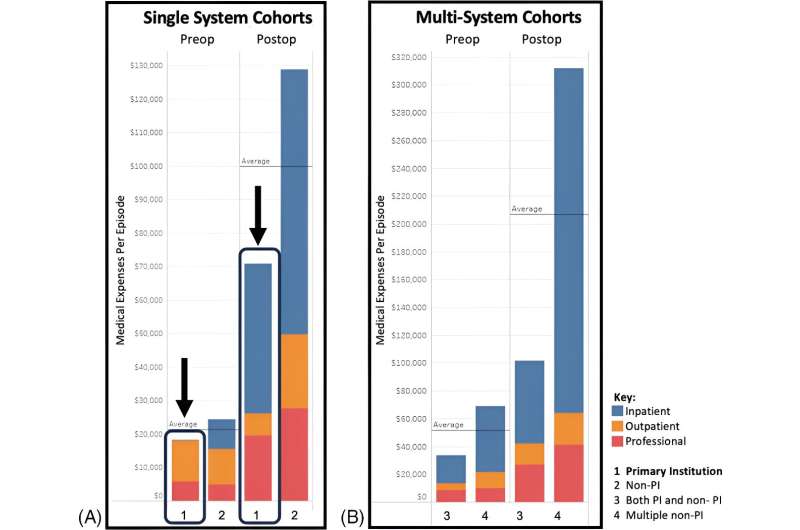This article has been reviewed according to Science X's editorial process and policies. Editors have highlighted the following attributes while ensuring the content's credibility:
fact-checked
trusted source
proofread
Optimal care, lower costs: Examining the benefits of out-of-network care for pediatric moyamoya

Moyamoya disease is a rare condition that affects the blood vessels in the brain, especially in children. Narrowing and blockage of vessels significantly increases the risk of stroke and requires surgical revascularization for treatment.
Although research shows that outcomes of revascularization are better at high-volume centers, insurers often hesitate to approve out-of-network care. However, a team from the Cerebrovascular Surgery and Interventions Center at Boston Children's Hospital found that allowing patients access to out-of-network high-volume centers for surgical revascularization can benefit all parties involved, including patients, health care providers, and insurers.
The study, the first of its kind to examine U.S. health care costs and patient outcomes for pediatric moyamoya treatment and how they are influenced by private insurance, was published in Stroke: Vascular and Interventional Neurology.
Making the argument for high-volume centers
The study looked at data from 125 pediatric patients who underwent surgical revascularization for moyamoya from January 2018 to December 2020. The primary institution (PI) cohort, comprising 22 patients, received inpatient care at the Cerebrovascular Surgery and Interventions Center, a high-volume center, while the others received care at lower-volume centers. A high-volume center was defined as one that performed more than six pediatric revascularization surgeries per year.
Results from the PI cohort demonstrate notable advantages. Despite their greater medical complexity and younger age (average age: 7), these patients experienced better clinical outcomes with fewer post-operative complications such as seizures and intracranial hemorrhages compared to those treated elsewhere.
Most patients with moyamoya have bilateral brain disease, and unlike many centers that conduct treatment over two separate operations during different hospitalizations, Boston Children's has pioneered treating both sides under a single anesthetic. This approach not only saves time and travel but also significantly lowers risk to patients, most notably during the critical procedure points of anesthesia induction and wake-up.
In this study, 95% of Boston Children's patients completed their treatment with a single surgical procedure, whereas 27% of non-PI patients required follow-up surgery. This discrepancy underscores the safety and efficiency of single-anesthetic bilateral revascularization surgery in moyamoya care.
This innovative approach from Boston Children's is now incorporated into the latest American Stroke Association guidelines for pediatric stroke management.
The results also suggest the potential for significant cost savings: The PI cohort had an overall 42% lower treatment expense compared with patients treated at lower-volume centers ($89,000 versus $153,000). The PI group was able to reduce the costs outside of their insurance network by working closely with local clinicians before and after the surgeries. This approach was used in 68% of cases.
"This study really highlights the benefits of a partnership care model where patients undergo surgery at a high-volume center but receive pre-and post-op care more locally," says Ed Smith, MD, MBA, co-director of the Cerebrovascular Surgery and Interventions Center and the paper's lead author.
"Boston Children's has carefully evolved treatment strategies to optimize in-network and local testing and follow-up, reducing out-of-network exposure for insurance providers and minimizing families' time away from home."
Painting a bigger picture
Ultimately, the study supports the practice of creating centers of excellence tailored to rare conditions requiring limited, complex treatments. It also highlights the benefits of partnerships between insurance companies and high-volume medical centers specializing in specific conditions, offering high-quality care at lower costs.
Smith and the team are optimistic that their findings provide a compelling argument for reevaluating care referral practices to prioritize high-volume centers, leading to reduced costs, improved clinical outcomes, and increased patient retention within the network for long-term care.
The study also provides valuable insights for managing other complex conditions and procedures.
"Our hope is that this approach serves as a model for treating other rare diseases requiring specialized care," says Smith.
More information: Shivani D. Rangwala et al, Referral of Pediatric Moyamoya for Revascularization: Financial and Quality Data Supporting Private Insurer Approval for Out‐of‐Network Care, Stroke: Vascular and Interventional Neurology (2024). DOI: 10.1161/SVIN.123.001014





















